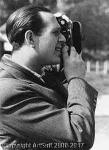Fred Stein
Fred Stein
Place: Dresden
Born: 1909
Death: 1967
Biography:
Fred Stein was a street photographer in Paris and New York after he was forced to flee his native Germany by the Nazi threat in the early 1930s. He explored the new creative possibilities of photography, capturing spontaneous scenes from life on the street. He was also a portraitist, photographing many of the great personalities of the 20th century.
Stein was born on July 3, 1909, in Dresden, Germany. His father, Dr. Leopold Stein, was rabbi of the Dresden Conservative community. He died when Fred was six, and his mother, Eva Wollheim Stein, became a religion teacher. Though their circumstances were reduced, his mother encouraged his intellectual and artistic education by enrolling him in good schools and subscribing to the many museums in Dresden, which Stein "haunted as a youth" (as he later said). Stein was bright and twice skipped grades at the Gymnasium (the German high school), a rare occurrence in those days. He was also intellectually curious and read extensively. At sixteen he joined the Socialist Youth Movement (the democratic option in Germany at that time). He was quick to perceive the threat of Adolf Hitler, and became quite active in the anti-Nazi movement.
He decided to become a public defender out of a concern for the plight of the poorest citizens, and attended law school at the University of Leipzig, from which he graduated after three years, in 1933. He worked in the State Prosecutors Office of Dresden as a prerequisite for obtaining his lawyer's certification. Three weeks before he was to receive the German equivalent of admission to the bar, he was dismissed by the Nazi government for "racial and political reasons", and was forbidden as a Jew to use the public library, halting the work on his PhD thesis.
In January 1933, when Hitler came to power, Stein's anti-Nazi activity became more committed, and also more dangerous. Dresden was a scene of a particularly strong Fascist crackdown, and arrests were increasingly common. Yet Stein continued to give lectures and to ride around on his bike, distributing Anti-Nazi literature in the streets.
In August 1933, Stein married Liselotte (Lilo) Salzburg, the daughter of an eminent Jewish physician. Guards at the Justice of the Peace greeted them with "Heil Hitler" salutes. Working as a law consultant in a factory – the only job available to him at this point – Stein received a clandestine warning one night from the son of the factory owner. The SS was asking questions about him, and one of the other workers in the factory had been arrested that day and put into prison. A close friend had written, urging them to come to Paris, and they left the next day under the pretext of a honeymoon trip.
Paris in the 1930s was a vital art scene. Emigres from all over Europe were drawn there, with new ideas influenced by the new "Modernism". Artists drew upon the zeitgeist and upon each other's work, producing a wave of inspired vision. Stein and his wife Lilo lived among a circle of expatriate artists and socialists and philosophers, frequenting the cafes and engaging in long conversation. The Steins were some of the lucky few with an apartment, and there they sheltered refugees and cooked huge meals to feed their friends. Robert Capa's companion Gerda Taro, had a room in their apartment. And a frequent visitor was Willy Brandt, who later (in 1969) became Chancellor of Germany.
Unable to work as a lawyer, Stein took up photography using the first model Leica camera he and his wife had bought each other as a wedding present. He began to explore the streets of Paris, looking and learning. It quickly developed into a passion: shooting every day, and studying whatever photo books he could find at night.
When France declared war on Germany in 1939, Stein was put in an internment camp for enemy aliens near Paris. Later, in the confusion of the Nazis’ approach to Paris, he escaped and made his way south, hiding in isolated farmhouses. He sent word through underground channels to his wife Lilo, alone in now-occupied Paris with their one-year-old girl, to meet him. Posing as a French national, she maneuvered her way through German controls, obtained a safe-conduct, and was reunited with Stein in a secret location. They made their way to Marseilles by hiding in the bathrooms of trains; in Marseilles they obtained danger visas through the Emergency Rescue Committee. On May 7, 1941, the three boarded the SS Winnipeg, one of the last boats to leave France. They carried only the Leica, some prints, and the negatives.
In the freedom of New York, the energy of the city infused Stein's work. He added the medium-format Rolleiflex, which takes pictures in a square format.
The city's cultural mix fit perfectly with his talents and concerns. He took to the streets and ranged from Harlem to Fifth Avenue, invigorated by the bustle and variety of the New World. He loved the American spirit; and as an outsider, he came to the various ethnic areas without preconceived ideas. He was able to see in the residents a style, humor and dignity that seems fresh, even today, as evidenced in "Little Italy" 1943.
More...
Wikipedia link: Click Here



